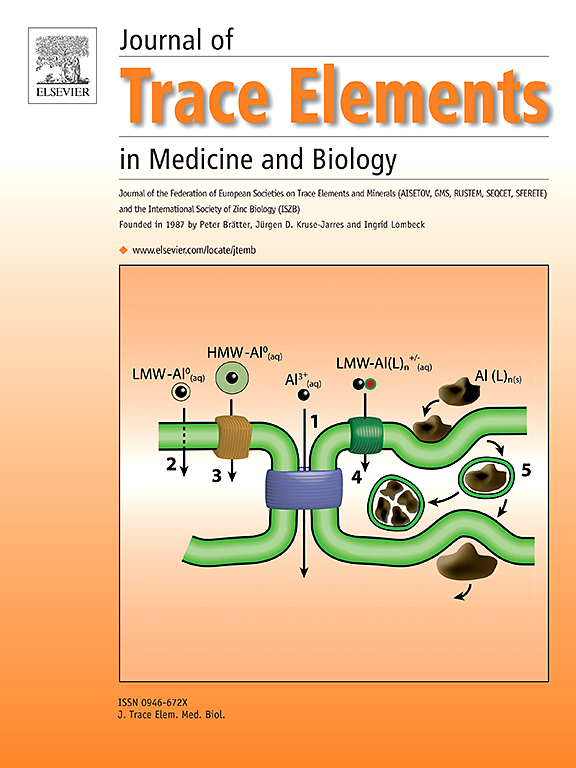由微量元素驱动的人类致病真菌红色毛癣菌分泌蛋白酶表达的上调。
IF 3.6
3区 医学
Q2 BIOCHEMISTRY & MOLECULAR BIOLOGY
Journal of Trace Elements in Medicine and Biology
Pub Date : 2025-02-01
DOI:10.1016/j.jtemb.2024.127580
引用次数: 0
摘要
背景:红毛癣菌是一种广泛分布的人类致病真菌,定植于人体外部角化组织。因此,病原体依赖于宿主提供的营养。病原体的侵袭机制依赖于分泌的蛋白酶,蛋白酶水解皮肤蛋白供后续吸收。方法:采用RNAseq对分泌蛋白酶的基因表达进行分析。在结果中,我们展示了31个分泌蛋白酶基因在三种条件下的表达谱:角蛋白培养基和含有微量元素或葡萄糖的角蛋白培养基。结果:在角蛋白培养基中添加微量元素后,分泌蛋白酶的表达由1.8 %增加到3.3 %。在所有分泌蛋白酶组中,观察到较高的表达。基因SUB4、MEP1、MEP3、MEP5、MEP9、LAP1、LAP2和MCPA表达显著增强,其中MEP5(~ 6倍)和SUB4(~ 5.8倍)表达最强。讨论:讨论微量元素对分泌蛋白酶的影响及意义。此外,我们推测银屑病和特应性皮肤的营养免疫紊乱是增加严重的T. rubrum感染风险的因素。本文章由计算机程序翻译,如有差异,请以英文原文为准。
Trace-elements driven up-regulation of secreted proteases expression in the human-pathogenic fungus Trichophyton rubrum
Background
Trichophyton rubrum is a widespread human pathogenic fungus, colonizing keratinized tissue of outer body-parts. Thereby, the pathogen is relying on nutrients available from the host. The invasive mechanism of the pathogen is relaying on secreted proteases, which hydrolyze skin-proteins for subsequent up-take.
Methods
In this study, we analyzed the gene expression of secreted proteases by RNAseq. In the results, we show the expression profile of 31 secreted protease genes under three conditions: keratin medium and keratin medium with trace-elements or with glucose.
Results
By adding trace-elements to keratin medium, the expression of secreted proteases increased from 1.8 % to 3.3 %. Across all groups of secreted proteases, higher expression was observed. The genes SUB4, MEP1, MEP3, MEP5, MEP9, LAP1, LAP2 and MCPA were significantly stronger expressed, whereby MEP5 (∼6 fold) and SUB4 (∼5.8 fold) were strongest up-regulated.
Discussion
We discuss the influence and significance of trace-elements on secreted proteases. Further, we speculate about the disturbed nutritional immunity in psoriatic and atopic skin as factor for increased risk of getting severe T. rubrum infections.
求助全文
通过发布文献求助,成功后即可免费获取论文全文。
去求助
来源期刊
CiteScore
6.60
自引率
2.90%
发文量
202
审稿时长
85 days
期刊介绍:
The journal provides the reader with a thorough description of theoretical and applied aspects of trace elements in medicine and biology and is devoted to the advancement of scientific knowledge about trace elements and trace element species. Trace elements play essential roles in the maintenance of physiological processes. During the last decades there has been a great deal of scientific investigation about the function and binding of trace elements. The Journal of Trace Elements in Medicine and Biology focuses on the description and dissemination of scientific results concerning the role of trace elements with respect to their mode of action in health and disease and nutritional importance. Progress in the knowledge of the biological role of trace elements depends, however, on advances in trace elements chemistry. Thus the Journal of Trace Elements in Medicine and Biology will include only those papers that base their results on proven analytical methods.
Also, we only publish those articles in which the quality assurance regarding the execution of experiments and achievement of results is guaranteed.

 求助内容:
求助内容: 应助结果提醒方式:
应助结果提醒方式:


